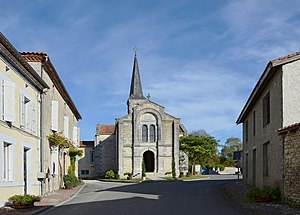Deviate
| Deviate | ||
|---|---|---|
|
|
||
| region | Nouvelle-Aquitaine | |
| Department | Charente | |
| Arrondissement | Angoulême | |
| Canton | Tude-et-Lavalette | |
| Community association | Lavalette Tude Dronne | |
| Coordinates | 45 ° 25 ′ N , 0 ° 1 ′ E | |
| height | 74-167 m | |
| surface | 8.42 km 2 | |
| Residents | 143 (January 1, 2017) | |
| Population density | 17 inhabitants / km 2 | |
| Post Code | 16190 | |
| INSEE code | 16118 | |
 Deviat - the townscape |
||
Deviate ( Occitan : identical) is a municipality and a town with 143 inhabitants (at January 1, 2017) in the western French department of Charente in the region Nouvelle-Aquitaine . The community consists of several hamlets ( hameaux ) and individual farmsteads .
location
The place Deviat lies in the old cultural landscape of the Angoumois , part of the Charente , at an altitude of about 100 m above sea level. d. M. and is about 36 km (driving distance) in a south-easterly direction from the city of Angoulême .
Population development
| year | 1800 | 1851 | 1901 | 1954 | 1999 | 2013 |
| Residents | 209 | 444 | 309 | 267 | 158 | 149 |
The population decline in the late 19th and first half of the 20th century is mainly due to the loss of jobs as a result of the phylloxera crisis in viticulture and the increasing mechanization of agriculture .
economy
While the residents of the village lived for centuries as self-sufficiency from the yields of their fields and gardens, viticulture was promoted in the late Middle Ages and early modern times, although - after the phylloxera crisis in the late 19th and early 20th centuries - it was not again its earlier Reached importance. Tourism also plays a not insignificant role for the economic life of the municipality in the form of renting holiday apartments ( gîtes ).
history
The history of the place is closely linked to the Château de la Faye , where the landlord family lived. In 1598, at the instigation of the then landlord, Deviat received the privilege of holding four market days a year, which was certified by Henry IV . In the absence of records, nothing is known about events during the Hundred Years War (1337–1453) or the Huguenot Wars (1562–1598).
Attractions
- The parish church of Saint-Hilaire was supposedly built in the 18th century, which would be quite unusual for a building in neo-Romanesque style. Large parts of the wall surfaces - with the exception of the corner stones - are plastered. The interior of the church, which was renovated in 2014, presents four windows with figures of saints below which the names of the local soldiers who fell in World War I are written.
- outside
- The Château de la Faye , a country estate with a history dating back to the 13th century, is located in a wooded property about one kilometer southeast of the town ( 45 ° 24 ′ 41 ″ N , 0 ° 1 ′ 4 ″ E ) . However, today's buildings essentially date from the 16th and 18th centuries. The castle chapel was demolished in the 19th century . The farm buildings (barns, workshops, etc.) are still preserved. The palace has been recognized as a monument historique since 1992 .
Web links
Individual evidence
- ↑ Deviat - Viticulture
- ↑ Château de la Faye, Deviat in the Base Mérimée of the French Ministry of Culture (French)

